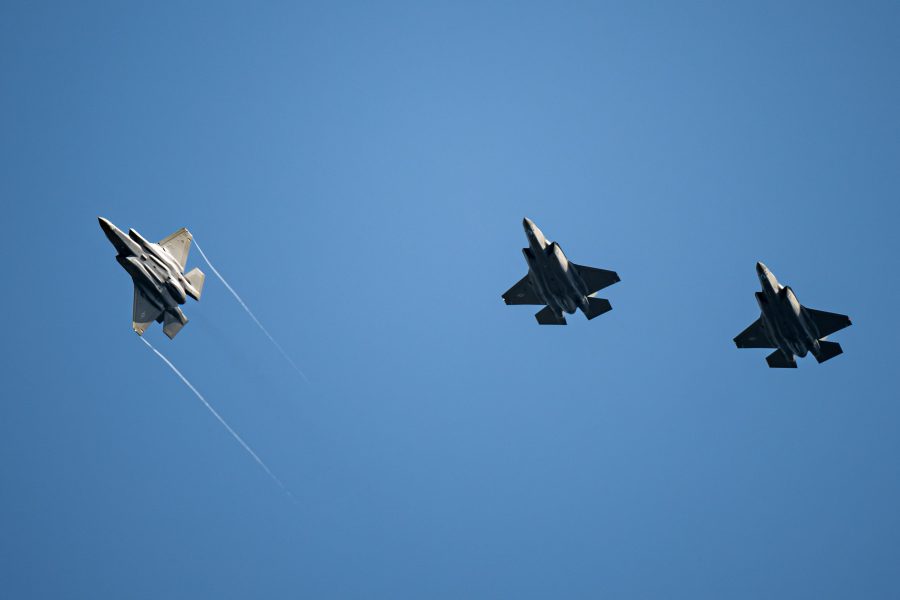Pentagon investment over the past decade has so favored research and development over procurement that it “has left the Joint Force increasingly undersized, outdated, and less likely to prevail in high-intensity conflict against a peer,” according to a new report from the Center for a New American Security.
The Oct. 21 report calls the Air Force’s combat fleet “smaller than at any other time in recent history” and authors Carlton Haelig and Philip Sheers call on DOD to redirect “runaway” R&D spending to buy production-ready F-15EX, F-35, and B-21 jets.
“The United States now faces a near-term window of increasing vulnerability in which China may believe that the PLA could defeat the United States,” they warned. “The United States must procure more forces that can be fielded quickly while continuing to fund advanced technologiesand help them transition to production as quickly as possible,” the CNAS report states. “Both actions are needed to strengthen deterrence against China in the near and long term.”
The Air Force has always leveraged advanced technology and invested more heavily in research, development, test, and evaluation than the Army and Navy. The Space Force is even more technologically based, and does so at an even greater rate.
Yet it is only since the late 2010s that the RDT&E budget has grown out of proportion, exceeding the procurement budget for the first time in service history. Even in the 1980s, when USAF fielded a new ICBM missile, the F-117, F-15, B-2, and more, that didn’t happen, noted retired Col. John “JV” Venable, now a fellow at AFA’s Mitchell Institute for Aerospace Studies.
The Air Force’s 2026 budget request sought $46.4 billion in RDT&E—28 percent more than the $36.2 billion sought for procurement. The Army and Navy also increased their RDT&E budgets, but CNAS found the Department of the Air Force was alone among the military departments spending more on research than procurement.
Over the past decade, the Air Force’s RDT&E budget grew 136 percent, far more than double the growth in its procurement budget (61 percent) over the same timeframe.
The result is a shrinking Air Force fleet, with aircraft retiring faster than replacements arrive. The total inventory shrank below 5,000 airframes for the first time ever, and is now headed toward 4,000.
Venable reached a similar conclusion in his own research paper published last month.
“Service funding for RDT&E is at a historic high with little capability to show for it,” Venable wrote. “The divest to invest approach only accelerated the erosion of today’s force. While innovation is positive and necessary, military value is only realized if operational systems are procured in adequate numbers and kept ready.”
The CNAS report examines five “major capability areas” where the Pentagon should rebalance R&D and procurement budgets, including combat aircraft and space.
Acknowledging the need to develop next-generation capabilities in the new F-47 air dominance fighter, Haelig and Sheers note that its “full-scale procurement, delivery, and deployment are unlikely in this decade and may not even occur in the 2030s.”
They argue for increased buys of F-35s, noting that RDT&E costs for that program have continued to rise even as procurement has slowed. Indeed, the Air Force slashed its planned F-35 buy in 2026, as officials wait for the Block 4 upgrade.
“With the F-47 far from complete, the F-35 remains the only U.S. stealth fighter in production, making it imperative to correct its investment profile by driving down the cost of block upgrades and buying more upgraded jets,” the authors write.
CNAS also calls for buying more upgraded fourth-generation F-15EX fighters to build out capacity of the fighter fleet and increasing acquisition of new, lower-cost unmanned Collaborative Combat Aircraft, saying the Pentagon should “expedite production and fielding of these systems.”
The B-21 bomber represents a “significant opportunity to bring a new capability to the field in the near term,” the authors write, recommending the Air Force build more than the planned 100 aircraft.
Venable agreed with CNAS recommendation to increase production of every aircraft type, but took issue with the CNAS report’s recommendation to ramp up production of the Army’s ground-based long-range fires. Such capabilities would not be as effective as airpower, he said.
Venable also argued for even more urgency—while the CNAS report makes short-term and long-term recommendations, Haelig and Sheers did not detail dollar amounts or timelines. In contrast, Venable has called for the Air Force to shift $6.6 billion from RDT&E in its 2026 budget to readiness and procurement and to invest another $8.7 billion per year to increase F-35 buys to 72 jets per year for the Air Force, the F-15EX to 24 jets per year, and the B-21 to 21 jets per year.


